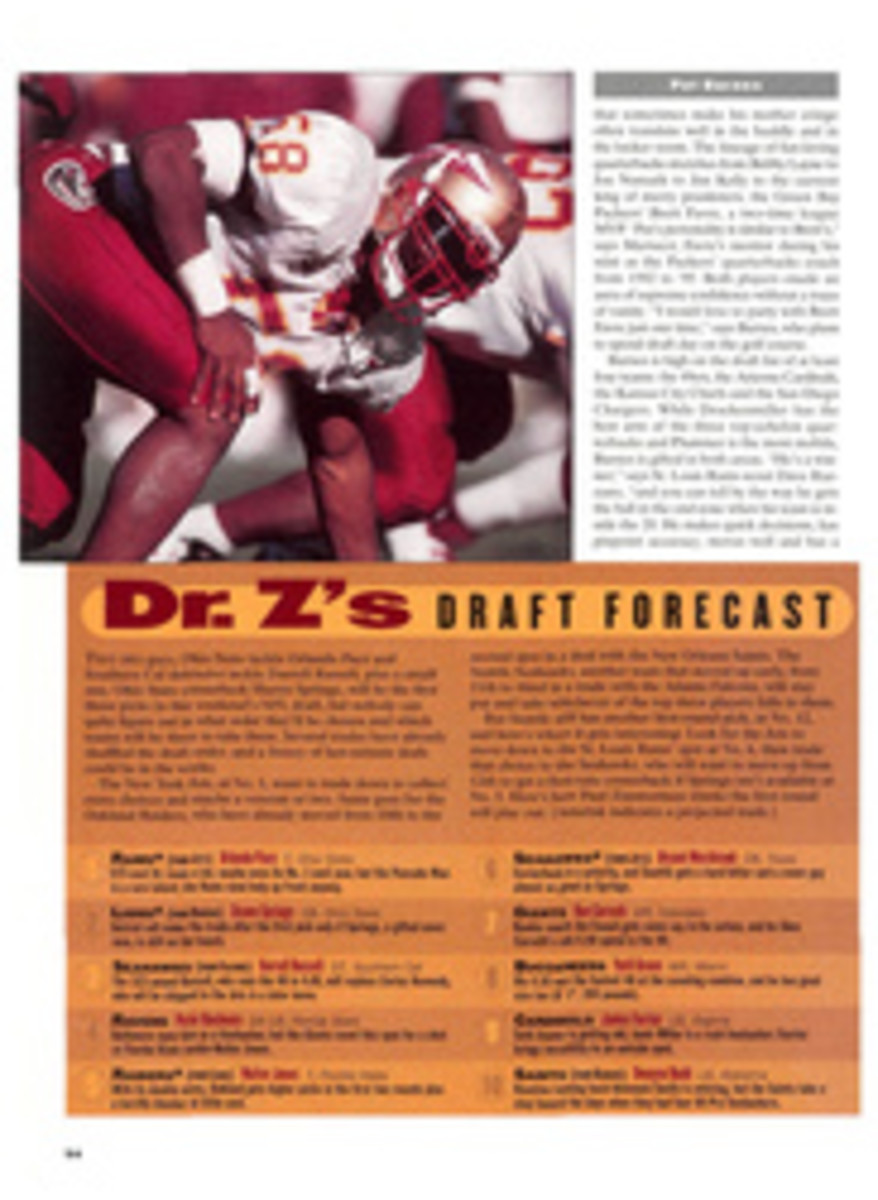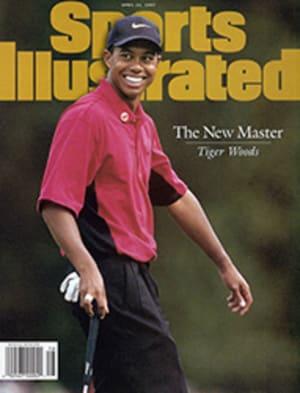
THE MAN BEHIND THE MEN THE TOP PLAYERS IN THE GAME PUT THEIR TRUST IN DAVID LEADBETTER
On the practice range, where so much is revealed to those with
the vision to see, David Leadbetter is the man with the X-ray
eyes. An angular, Ichabod Crane-like figure in a wide-brimmed
hat, Leadbetter customarily stands a few paces from one of the
world's best players with his feet wide apart and his arms
folded, filtering information through the circuitry behind his
high-tech sunglasses. As Leadbetter watches in his unhurried
way, other players sneak anxious looks at him, waiting for their
turn to hear the words that might make a disjointed swing fall
into place.
Leadbetter established his credibility a decade ago when his
student Nick Faldo won his first major championship with a
rebuilt swing, and Leadbetter's aura of authority has grown to
the point where he is as recognizable to casual fans as many of
the players who rely on him.
At the Masters, Leadbetter oversaw Ernie Els, Faldo, Greg Norman
and Nick Price, an unprecedented fearsome foursome of pupils.
Leadbetter also coaches about a dozen other touring pros,
including Brad Faxon, David Frost, John Huston, Bernhard Langer
and Mark McNulty. At one time or another he has worked with Seve
Ballesteros, Sandy Lyle, Mark O'Meara, Scott Simpson, Tom Watson
and Ian Woosnam. Leadbetter's videos, books, training products,
corporate clinics and academies dominate the instructional
market. At 44 he is Lord Lead, as Faldo calls him, the most
respected teacher in the game. "David's success made people
realize the value of golf instruction and how it can even help
the best players in the world," says Butch Harmon, who coaches
Tiger Woods, among others. "All the teachers in the game owe him
a debt of gratitude. He gave us all credibility. He was the
pioneer."
On the range Leadbetter never stands in one place for long. He's
constantly shifting position. Is it to observe from a different
angle? "No," says Price. "He's uncomfortable because he knows
he's standing in the gallery's way. He's self-conscious that
he's on a stage where he doesn't belong, so he's always dancing
about. In a nutshell, that's David."
Characterizing any of today's self-promoting swing gurus as
self-conscious is a tough sell, but portraying Leadbetter that
way is harder still. He's in many golf magazines and TV
commercials, and makes the Golf Channel seem like Late Night
with David Leadbetter. To those who know him well, it is
Leadbetter's ability to empathize that's not only at the heart
of the man but also the key to his success. "David knows as much
about the golf swing as anyone, and he has an absolutely
incredible eye," says Price, who was nine when he first met the
14-year-old Leadbetter at a junior tournament in what was then
Salisbury, Rhodesia. "But his real gift is a sense for people,
what they are feeling, how they learn. He knows how to reach
people."
Leadbetter's wife of 13 years, Kelly, a former player on the
LPGA tour, says that when he gets a 3 a.m. call at their Lake
Nona home outside Orlando from a desperate player in some
far-flung corner of the world, Leadbetter's voice immediately
becomes fully alert. "I think that kind of energy and attention
is a product of doing something you love," she says. "It's like
his brain always has this little golf department going on."
Recently at the Cooper Clinic in Dallas, where Leadbetter was
indulging an obsession with exercise and proper diet that grew
from being a sickly child, he was asked for a lesson just as he
was about to enter an immersion tank to measure his body fat.
"I'm standing there stark naked, and the attendant asks me to
check his swing," says Leadbetter. "He's holding this pole with
a screen at the end that they use to clean stuff out of the
tank, so we used that as the club. I never really get away from
it."
Leadbetter finds it almost impossible to turn away a top pro,
and as his stable of players expands, his reputation for being
late, and the suspicion that he's stretched too thin, also grow.
But it is the challenge and process of helping a player get
better that's his passion. "I'm like a doctor," he says. "If
somebody's ill and I can make them better, I'm going to try."
He comes from a healing tradition. The story of Leadbetter's
maternal grandparents, George and Dorothy Thomas, now deceased,
make for a better tale than The English Patient. The pair were
in love as teenagers when World War I broke out. George joined
the British army and was sent to the Western front, where he was
blinded by a bullet wound during the Battle of the Somme. When
George returned from France he married Dorothy and went on to
become a renowned osteopath, a sightless man with magic hands.
"My father had a gift for soothing people with massage, I
suppose in part because his sense of touch was made more acute
by having lost his sight," says Leadbetter's mother, Patricia,
who lives with her husband, Douglas, in the coastal town of
Rustington in Sussex, England. "At the same time, my mother and
I had to be very conscious about helping my father, so I suppose
some of these qualities were passed on to David."
A serious case of childhood asthma also had an effect on
Leadbetter's character. His condition played an important role
in his father's decision to move the family of five from England
to Zimbabwe when David was six. By that time the stress of
wheezing for air had caused the boy's sternum to protrude, a
deformity that left a psychological scar. "That was a bit of a
trauma," Leadbetter admits. "Kids are cruel, so I went into my
shell for a while there. It probably made me a little bit of the
outsider, always watching, always thinking, trying to figure out
what made people tick."
Leadbetter was drawn to all sports and excelled in cricket,
field hockey and track. But it was golf that really captured the
introspective loner. By 16, he was a two handicap, with
aspirations to play professionally. "David was a good player,"
remembers Price, "but what I remember about him was every time I
went in the pro shop, he had his nose in a golf book or
magazine. He has always loved the dynamics and the mystery of
the swing."
After turning pro at 17, Leadbetter struggled. "I had a great
short game and a lot of imagination, but I was always obsessed
with technique, always searching for perfect," he says. "What I
didn't realize until much later is that the reason you work so
hard on your swing is so that when you play, you can forget
about it. I remember being very nervous, very uncomfortable in
competition. I had a violent temper. I broke some clubs. I
needed a sports psychologist before there were any. I'm glad I
went through it, because it gave me an understanding of what the
guys I coach go through. So I don't take it personally when
they're difficult."
All the while Leadbetter was foundering with his game, he was
having success teaching at a local club. "In the end, becoming a
teacher was an easy decision," he says. It quickly became
Leadbetter's goal to come to the U.S., and by 1980 he had landed
a position as assistant pro at Oak Park Country Club in Chicago.
Two years later he took a full-time teaching position at
Grenelefe Resort near Haines City, Fla. It was there that
Leadbetter established the headquarters where players like
Price, Denis Watson and, in early 1985, Faldo would build their
games. Since 1989 the Lake Nona Club has been home base for the
Leadbetters and their three children, Andy, 12, Hally, 4, and
James, 2.
Leadbetter was one of the first instructors to make extensive
use of videotape, with which he debunked many of the swing
theories that were prevalent in the 1970s. "David studied what
the best players were doing and made some breakthroughs," says
Gary Smith, an instructor and a commentator for the Golf Channel
who used to work with Leadbetter. "He also looked at film of
players like Sam Snead and Ben Hogan and decided that what they
did was sounder than what the players of the '70s and early '80s
were doing. The essential concept is that power comes from the
rotation of the trunk, not from driving the legs toward the
target. The swings of players such as Steve Elkington and Tiger
Woods--today's model swings--have been influenced by David."
Because their hands are less active, golfers coached by
Leadbetter tend to be medium to short hitters who sacrifice
distance for accuracy. "It's a trade-off," says Leadbetter, "but
control of the ball is the ultimate goal. That's how the Nicks
have won their majors." (Faldo has won six, Price three.) With
Els and Norman, both long hitters, Leadbetter has worked to
quiet their legs and hands in the interest of control and
consistency.
The rap on Leadbetter is that his so-called method is too
complicated. Critics point to the demise of Ian Baker-Finch and
Bob Tway as evidence that Leadbetter's teaching can lead to
paralysis by analysis. Leadbetter answers that while he hasn't
always had success, calling him inflexible or complex is
inaccurate. "A lot of people have labeled me a method teacher,
but working with the group of players I have, that are so
different, I can't be," he says. "You can't try to make a master
race of players. They may be cloning sheep, but you can't clone
golfers."
Unlike other teachers, who feel they haven't received enough
credit from the players they've helped, Leadbetter has always
been given his due, particularly by Faldo. There was potential
for strain in Leadbetter's decision last October to take on
Norman, as well as in Faldo's recent foray into the golf school
business. "I don't feel diminished that David has been
instrumental in my development, because I'm still the one who
has to pull the club back," says Faldo. "When you stand out
there on the 18th fairway with an Open championship on the line,
nothing, nobody, helps you there. It's just you. That's my
satisfaction. David helped me to get there. I suppose that's his
satisfaction. He's always been that sort of person."
X-ray eyes or not, he is rare.
COLOR PHOTO: PHOTOGRAPHS BY BEN VAN HOOK Leadbetter keeps tabs on the swings of more than a dozen pros, including Price. [David Leadbetter watching Nick Price play golf]
COLOR PHOTO: BOB MARTIN Faldo (top), Johnny Miller (middle) and Norman are among the golf royalty who seek out Lord Lead. [David Leadbetter instructing Nick Faldo]
COLOR PHOTO: PHOTOGRAPHS BY BEN VAN HOOK [See caption above--David Leadbetter and Johnny Miller]
COLOR PHOTO: BOB MARTIN [See caption above--David Leadbetter instructing Greg Norman]
PHOTO: PHOTOGRAPHS BY BEN VAN HOOK Andy, 12, receives the benefit of his father's discerning eye at their backyard practice bunker at Lake Nona. [David Leadbetter watching Andy Leadbetter play golf]

